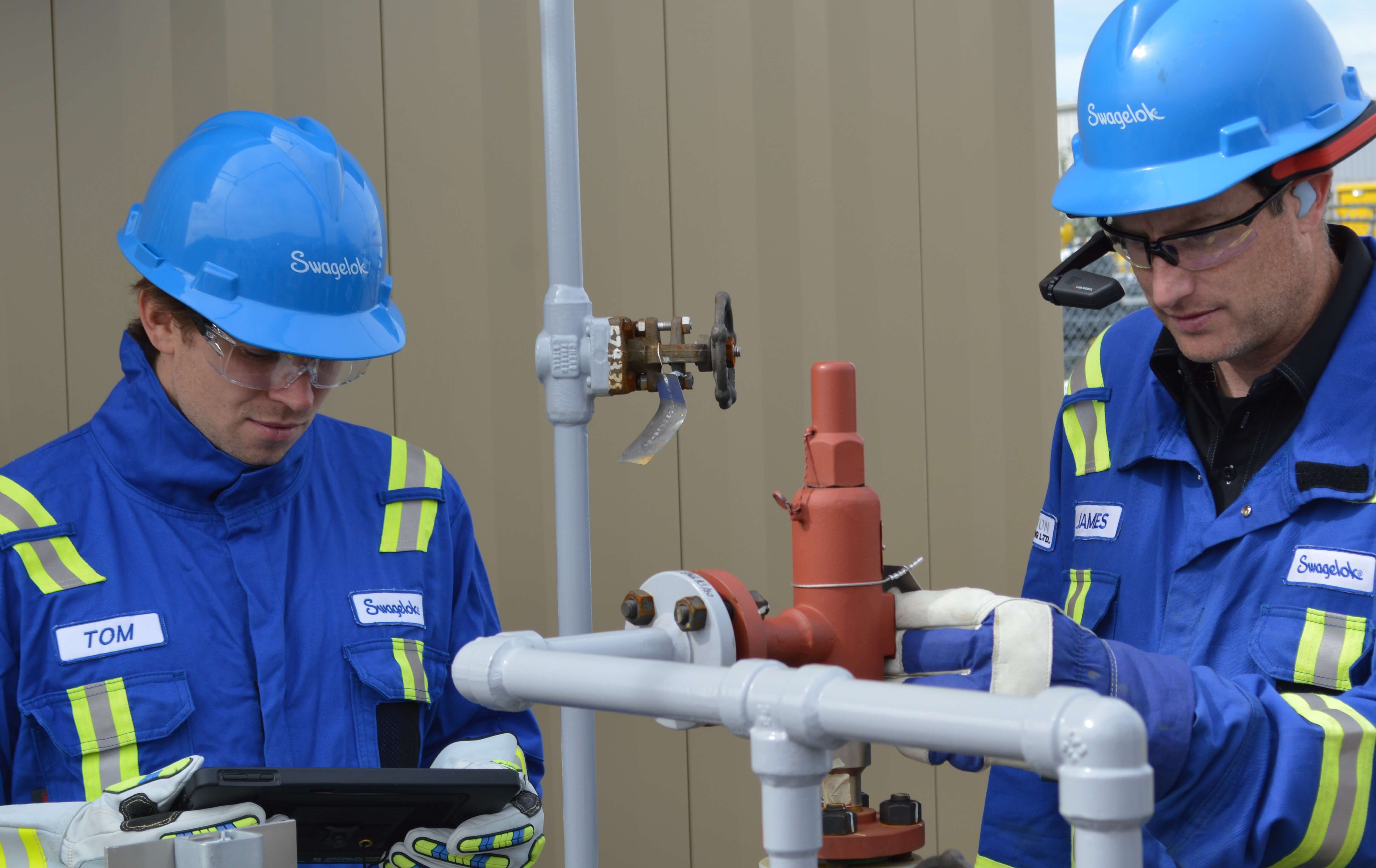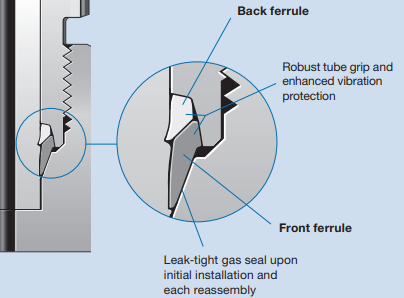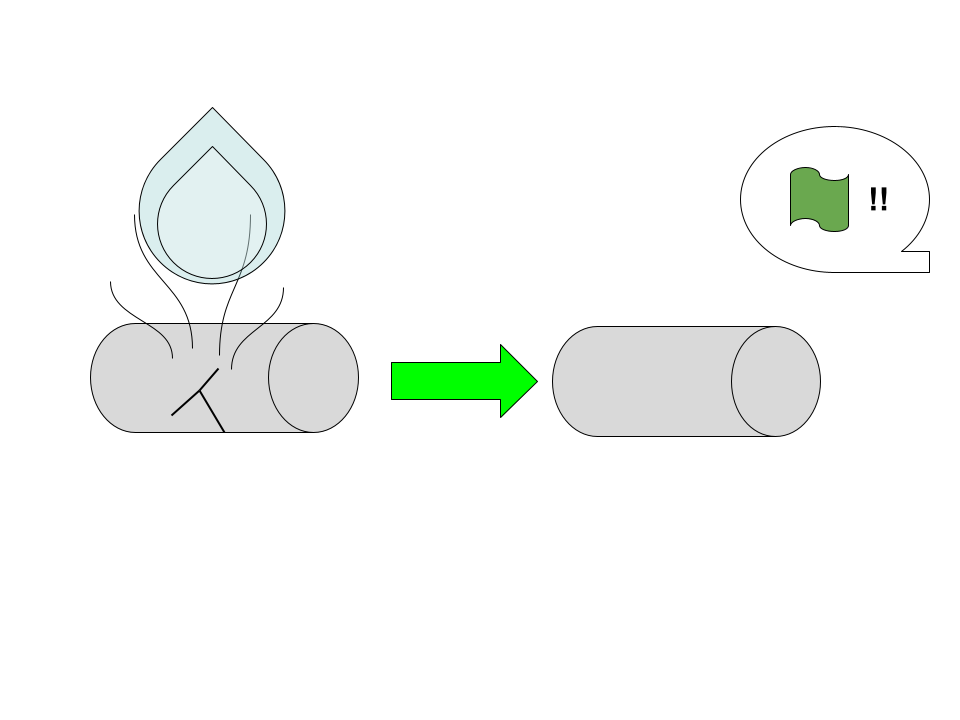Learn more about how Edmonton Valve & Fitting field advisors can help you protect your plant and workers.
 Establishing and maintaining hydrogen plant safety is simple: prevent leaks throughout the entirety of a fluid system. This, of course, is about as helpful as setting operational efficiency benchmarks at 100%—easy in theory does not necessarily translate to easy (or even feasible) in practice.
Establishing and maintaining hydrogen plant safety is simple: prevent leaks throughout the entirety of a fluid system. This, of course, is about as helpful as setting operational efficiency benchmarks at 100%—easy in theory does not necessarily translate to easy (or even feasible) in practice.
Some level of leakage can be an inescapable reality and sometimes an acceptable loss, especially when considering the size of the molecules involved in hydrogen production. That said, any efforts made to control and reduce leakage of the valuable fuel sources used in hydrogen facilities not only conserves product but will also reduce a plant’s fugitive emission levels.
Reducing fugitive emissions offers a dual financial incentive, as evolving emission guidelines include more expensive fines or greenhouse gas offset credits. However, the greatest economic benefit of all is the protection of employees, equipment, and property. Without appropriate equipment and maintenance, hydrogen can readily escape to the atmosphere, where it can form a flammable mixture with the atmosphere in volumetric ratios around 4-5%. Hydrogen flames are exceptionally difficult to detect in broad daylight, and the low level of activation energy necessary for combustion means any hydrogen leak is nearly certain to result in a fire.
The best way to prevent fires from leaked fuel sources is to prevent the leak in the first place. To do so, plants must leverage system components developed specifically for containing these molecules, a consistent approach to leak detection, and routine maintenance to identify leak points before they can develop further.
In this guide, we discuss several common classes of components that have been meticulously designed and rigorously tested to meet the high demands of hydrogen plant safety.
Regulators perform the crucial role of maintaining pressure across multiple system processes. They function as a tool of efficiency and stability, maintaining inlet and outlet pressures to surrounding components to ensure pressure optimization. As pressure regulators may operate with ratings up to 10,000 PSIG, the impermeability of the material is important.
Hydrogen, with its small atomic and ionic size, can readily penetrate many surrounding materials, especially at elevated pressures. This leads to hydrogen embrittlement, where the ductility of the metal is reduced and becomes more vulnerable to fatigue and eventual crack proliferation. To prevent embrittlement, material selection for direct-contact materials is paramount.
For relatively low-pressure concerns, an excellent stainless steel for this task is 316/316L, an austenitic alloy containing chromium, nickel, and molybdenum. The advantage of 316/316L (and other austenitic alloys) is the relative ductility and lower strain of austenitic to martensitic interstitial structures. An increase in ductility means an inherent reduction in brittleness, compounding the difficulty for hydrogen to diffuse into the metal. Further, the lower density of martensitic structures can form a pocket where hydrogen can continuously attack the metal. The family of RHPS pressure regulators have bodies built from 316L SS, which offers impressive corrosion resistance alongside the aforementioned hydrogen fatigue resilience to better reduce the incidence of leak point formation.
A diagnostic tool useful in leak detection of regulators is creep. Creep may be discerned when an increase in outlet pressure can be traced back to a seat leakage. Any otherwise unexplainable increases in outlet pressure should be a cause for investigation of the regulator seat by an operator. Certain designs, such as the self-centering poppet in the HF series, are better suited to handle the issue of creep.
 As the juncture between the tubing and associated components, tube fittings can be an essential part of any plan to combat fugitive emissions. The mechanism that drives the function of the fitting is the sets of front and back ferrules. The ferrules collaborate to create tight seals and reduce vibration sensitivity by the act of first driving the front ferrules into the tubing while the back ferrules hinge inward for increased tube grip. By operating directly on the fitting body and indirectly on the outer diameter of the tubing, the front ferrules can create a two-stage seal. From there, the fitting can offer additional benefits to the tube’s operating conditions:
As the juncture between the tubing and associated components, tube fittings can be an essential part of any plan to combat fugitive emissions. The mechanism that drives the function of the fitting is the sets of front and back ferrules. The ferrules collaborate to create tight seals and reduce vibration sensitivity by the act of first driving the front ferrules into the tubing while the back ferrules hinge inward for increased tube grip. By operating directly on the fitting body and indirectly on the outer diameter of the tubing, the front ferrules can create a two-stage seal. From there, the fitting can offer additional benefits to the tube’s operating conditions:
The surface finish of the tubing contributes greatly to the effectiveness of the seal created between it and the fitting. Defects incurred during installation or operation are likely to affect the ability of the seal to fully develop. To reduce the chances of failure at the seal, visually inspect and verify the surface is clean and free from nicks, scratches, or other surface abrasions that could inhibit seal formation.
Multiple factors during installation can lead to improper seal function. To reduce the incidence of leaks, operators should be confident in their ability to perform essential operations on the tubing. Whether an operator is bending tubes, offsetting bends, retightening fittings, or using an inspection gauge, Edmonton Valve & Fitting offers training that provides users with the knowledge and resources to ensure their work is both safe and effective. With in-person and virtual training seminars available, Edmonton Valve & Fitting can furnish training that is tailored to the individual needs of any facility.
Valves are the largest contributor to fugitive emissions across an entire fluid system, with the vast majority of those emissions arising from failure at the valve stem. For any rising stem valves, such as needle valves, one component of controlling fugitive emissions is ascertaining that the product is certified low emissions by American Petroleum Institute’s 624 standard. The API test submits the product in question to a battery of mechanical and thermal cycles, and a product is only able to gain certification if methane leakage remains at or below 100 ppm for the entire duration. To further drive down emissions, the 1 Series Needle Valves, as well as the N Series Needle Valves, contain additional leak-preventative features.
| 1 Series | N Series |
| 2-piece chevron packing with disc springs to assist seal and reduce wear |
316 stainless steel stem threads increase resistance to wear from cycling and prevent the formation of leak path via material degradation Nonrotating ball stem tip provides reliable shutoff while preventing leaks |
| Seats have a maximum leak rate of 0.1 std cm3/s | |
The Alternative Fuel Service (AFS) Ball Valves are a great fit for any hydrogen plant. All wetted components in the assembly are compatible with both hydrogen and compressed natural gas, vastly increasing its utility to a hydrogen facility. Much like the needle valves, the AFS ball valves feature an API certification for low emissions under the 641 standard. The AFS achieves 641 certification with an ultra low-temperature fluorocarbon material in the O-ring compatible over the full temperature range of the valve as well as a seat-loading technology with excellent leak integrity for low- and high-pressure operations.
As discussed above, the relative inertness between the 300 austenitic stainless steel alloys and hydrogen at low pressures makes metal tubing an indispensable piece of any hydrogen plant design. An internal helium leak test is conducted on all metal hoses, with an acceptable leakage rate seat at 1x10-5 std cm3/s. Product series such as the FX, FM, FJ, and FL possess a 316L stainless steel annular convoluted core and an additional 300 stainless steel alloy overbraid for pressure containment.
For metal hoses integrated into temperature-dependent lines, insulation may be the most efficient option for temperature control. While their primary role is maintaining energy efficiency, insulation also assists in hydrogen plant safety in several key ways. First, the Safe-to-Touch ASTM C1055 standard establishes a max temperature of 60°C to protect operators from incidental contact; when in contact with a 60°C hose, no permanent damage should occur within the first five seconds. The air convection and flow about the tubing are also important to prevent a build-up of ice or condensation that could create a slip-and-fall hazard. To circumvent this issue, allow for adequate spacing between thermal lines (> 31 cm) and avoid routing through tightly confined areas with poor ventilation.
Certain fluid system connections either require or benefit greatly by forming a permanent weld joint. Properly executed, a weld joint will form the least penetrable union possible, reducing the risk of leak development. While not viable in all circumstances, the ability to weld simple connections accurately and repeatably allows a facility to minimize downtime. An orbital welding unit and associated rigging offer the operator a high level of control over the weld puddle characteristics, and with a little training, can provide an indispensable tool in addressing simple welding jobs. A trained employee or welding professional with an orbital welding unit can enjoy multiple benefits relative to other welding systems:
 Every component throughout your fluid system plays a vital role no matter how big or small. For all these devices and their interfacings, fugitive emissions are an ever-present possibility. To best address leaks that may already exist in your lines and prevent future leak paths from forming, a consultation with an Edmonton Valve & Fitting Field Advisor can help maintain and develop your hydrogen plant safety. Keeping your valuable product where it’s intended to be so you can better serve your customers while protecting the health and wellness of your employees is something everyone can get behind.
Every component throughout your fluid system plays a vital role no matter how big or small. For all these devices and their interfacings, fugitive emissions are an ever-present possibility. To best address leaks that may already exist in your lines and prevent future leak paths from forming, a consultation with an Edmonton Valve & Fitting Field Advisor can help maintain and develop your hydrogen plant safety. Keeping your valuable product where it’s intended to be so you can better serve your customers while protecting the health and wellness of your employees is something everyone can get behind.

Lorem ipsum dolor sit amet, consectetur adipiscing elit. Suspendisse tempor nisi ut vehicula commodo.
Learn More →
Lorem ipsum dolor sit amet, consectetur adipiscing elit. Suspendisse tempor nisi ut vehicula commodo.
Learn More →
Lorem ipsum dolor sit amet, consectetur adipiscing elit. Suspendisse tempor nisi ut vehicula commodo.
Learn More →
Lorem ipsum dolor sit amet, consectetur adipiscing elit. Suspendisse tempor nisi ut vehicula commodo.
Learn More →
Lorem ipsum dolor sit amet, consectetur adipiscing elit. Suspendisse tempor nisi ut vehicula commodo.
Learn More →
Lorem ipsum dolor sit amet, consectetur adipiscing elit. Suspendisse tempor nisi ut vehicula commodo.
Learn More →
Lorem ipsum dolor sit amet, consectetur adipiscing elit. Suspendisse tempor nisi ut vehicula commodo.
Learn More →
Lorem ipsum dolor sit amet, consectetur adipiscing elit. Suspendisse tempor nisi ut vehicula commodo.
Learn More →
Lorem ipsum dolor sit amet, consectetur adipiscing elit. Suspendisse tempor nisi ut vehicula commodo.
Learn More →Swagelok is a $2B developer of industrial fluid system products and services. Swagelok Edmonton is an authorized Swagelok Sales and Service Centre serving Canadian companies in clean energy, chemical, oil and gas, and other industries. Proud member of the Canadian Council for Aboriginal Business.
Tel: 780-437-0640.
Swagelok Edmonton values your privacy. This website uses cookies to enhance user experience and analyze performance and traffic. Our policies are posted here.
Login/Register | Privacy | Safe Selection | Centre Locator | Sitemap | Legal
© 2012-2024 Edmonton Valve & Fitting Inc.